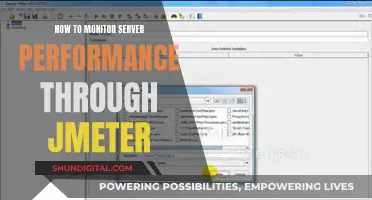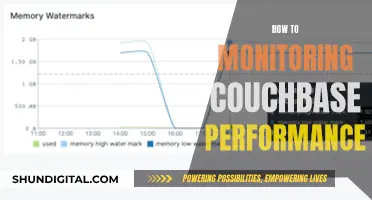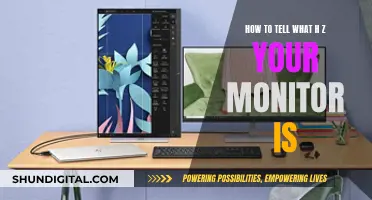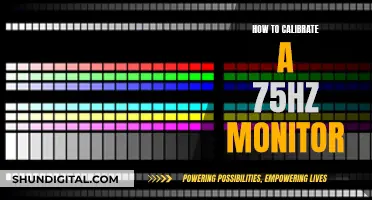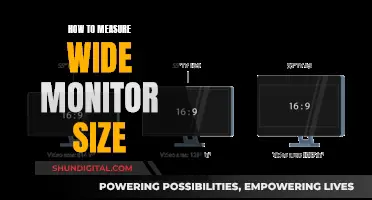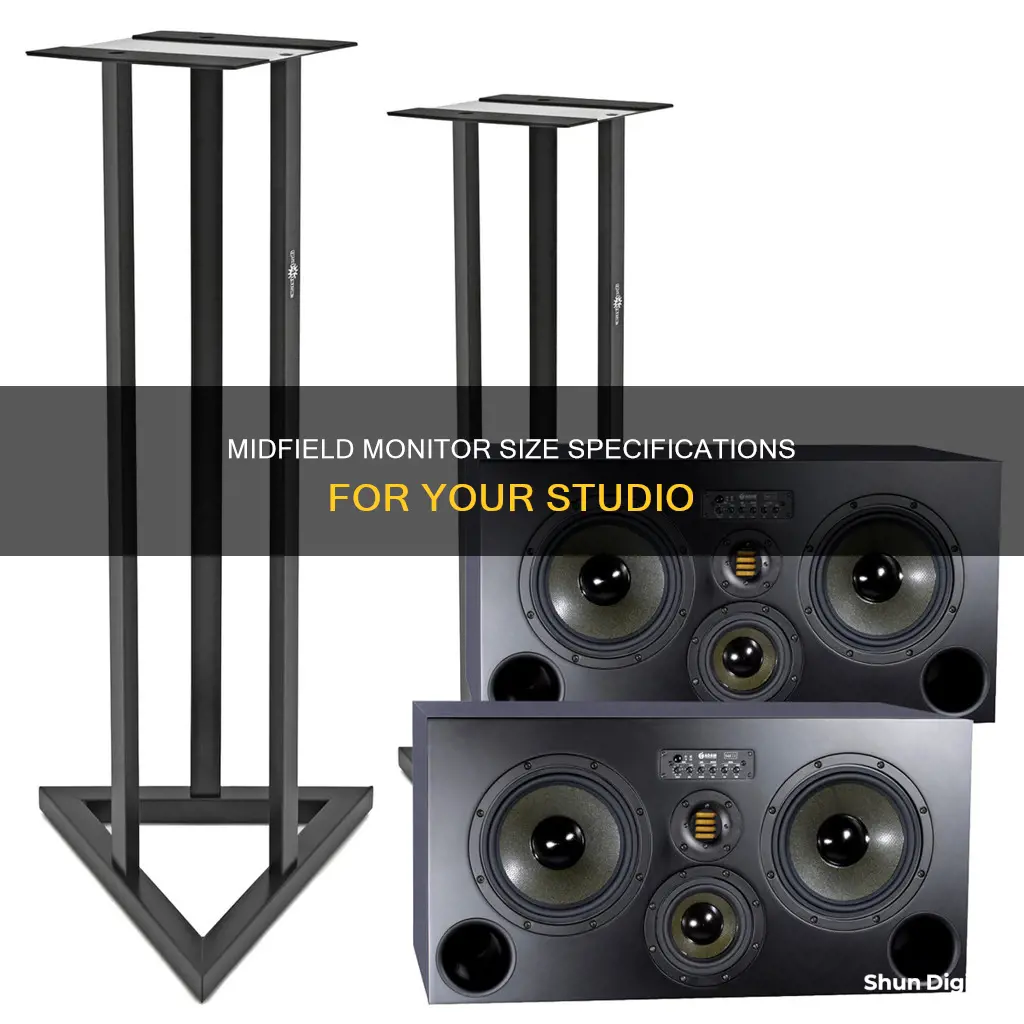
Studio monitors are an essential tool for audio professionals, allowing them to get an accurate assessment of their audio projects. Midfield studio monitors are larger than nearfield monitors but smaller than farfield monitors. They are designed to be placed 5 to 10 feet from the listener and are typically mounted on stands behind a console or workstation. The size and power of midfield monitors allow them to be placed at a greater distance from the listener without losing bass or detail. They also provide a larger sweet spot, making them ideal for collaborative projects. Midfield monitors typically use a three-way design with 8 to 10-inch bass drivers to deliver an even and balanced frequency response at moderate playback levels.
What You'll Learn

Midfield monitors are larger than nearfield monitors
Midfield monitors are ideal for larger spaces and higher volume levels. They are typically used in medium-sized studios and are designed to handle higher volume levels and provide a more full-bodied sound. They have larger woofers, typically 8-10 inches, and often use three-way designs with a dedicated midrange driver in addition to the tweeter and woofer. They also come with more powerful amplifiers and larger cabinets, which provide more bass extension and better mid- and high-frequency dispersion at greater distances.
The larger size and more powerful components of midfield monitors make them suitable for use in larger listening rooms and at greater distances. They can fill larger rooms with high-quality sound and be positioned further away from listeners without a loss of bass or detail. This makes them a good choice for those who work with others, as they provide a larger "sweet spot" for multiple listeners.
In contrast, nearfield monitors are typically small in size and have a compact design, making them ideal for smaller studios or spaces where space is limited. They usually feature a compact two-way system with a tweeter and a moderately-sized second driver handling midrange and bass frequencies.
While the specific dimensions of midfield monitors can vary depending on the model and manufacturer, they are generally larger than nearfield monitors to accommodate the larger drivers and cabinets required for their increased power and performance.
Deleting Frames on Your ASUS Monitor: A Step-by-Step Guide
You may want to see also

Midfield monitors are smaller than farfield monitors
Midfield monitors are smaller than far-field monitors. Far-field monitors are the large installments you often see in major studios. They are wall-mounted or installed directly into the wall, usually near the corners of the room. These monitors are placed at a distance of up to 10 feet or more from the listening position.
Midfield monitors, on the other hand, are larger and more powerful than near-field monitors. They are suitable for larger listening rooms and greater listening distances. Midfield monitors have larger woofers, typically between 8 and 10 inches, and often feature three-way designs with dedicated midrange drivers.
The size difference between midfield and far-field monitors is significant, with far-field monitors being much larger and more suitable for large studio spaces. Far-field monitors are designed to fill large spaces with sound and are commonly used in movie theatres and concert venues. They are also used in large studios for sound effects and background scoring.
The larger drivers and more powerful amplifiers of midfield monitors enable them to fill larger rooms with high-quality sound. They can be positioned further away from the listeners without a noticeable loss of bass or detail. This makes them a good choice for bigger studio spaces where multiple people are working together.
Monitoring CPU Usage: Performance Monitor Guide
You may want to see also

Midfield monitors are designed for larger rooms
Studio monitors are an essential part of the recording setup, as they allow audio professionals to get an accurate and honest assessment of their audio projects. One of the most important factors when choosing studio monitors is the size of the room where they will be used.
The main advantage of midfield monitors is their ability to fill larger rooms with high-quality sound. They can be positioned further away from the listeners without a loss of bass or detail, making them ideal for collaborative projects. They also provide a larger monitoring sweet spot, more volume, and a generally "bigger" sound.
However, it is important to note that midfield monitors are more likely to excite the room "modes" (acoustical cancellations and reinforcement at various bass frequencies related to the room's dimensions), which can lead to inaccuracies. Therefore, good room design and acoustical treatment are crucial when using midfield monitors.
Overall, midfield monitors are a great choice for professionals working in larger rooms who need higher volume levels and better bass extension. They provide a versatile and powerful solution for critical listening and monitoring in professional studio environments.
Viewing Your Website: Monitor Size Matters
You may want to see also

Midfield monitors are placed further from the listener
Midfield monitors are larger than nearfield monitors but smaller than farfield monitors. They are designed to be placed 5 to 10 feet away from the listener, typically mounted on stands behind a console or workstation. This distance is important because it allows for a more accurate listening experience, with the direct sound coming from the speakers being heard primarily, while reflections off the various room surfaces are minimised.
The placement of midfield monitors is crucial to achieving optimal sound. They should be positioned to form an equilateral triangle with the listener's head, with the monitors aimed directly at the listener's ears. This setup helps to ensure a consistent listening perspective and stereo image width across different studios.
In addition to the distance from the listener, the height of midfield monitors is also important. Ideally, the monitors should be positioned slightly above or below the midpoint between the floor and ceiling. This helps to minimise the impact of room acoustics, particularly standing waves created by sound waves reflecting off walls.
Midfield monitors are typically larger than nearfield monitors, with 8 to 10-inch woofers, and often use a three-way design with a dedicated midrange driver in addition to the tweeter and woofer. This larger size and more powerful amplification enable them to fill larger rooms with high-quality sound and provide a larger monitoring sweet spot, making them ideal for collaborative projects.
While midfield monitors can be placed further from the listener, it is important to note that they are more likely to excite room "modes", or acoustical cancellations and reinforcements at various bass frequencies related to the room's dimensions. This can lead to inaccuracies in the sound, so good room design and acoustic treatment are crucial when using midfield monitors.
Setting Up Your ASUS Portable Monitor: A Step-by-Step Guide
You may want to see also

Midfield monitors are ideal for collaborative projects
Midfield studio monitors are ideal for collaborative projects. They are typically larger than nearfield monitors and smaller than farfield monitors. Midfield monitors are designed to be placed 5 to 10 feet away from the listener and are often mounted on stands behind a console or workstation. This setup allows for a larger sweet spot, meaning multiple people can effectively listen and collaborate at the same time.
Midfield monitors usually feature a three-way design with 8 to 10-inch bass drivers, providing an even and balanced frequency response at moderate playback levels. Their larger size and more powerful amplifiers mean they can fill larger rooms with high-quality sound and be positioned further from listeners without any noticeable loss of bass or detail. This makes them ideal for collaborative projects in larger spaces.
The extended frequency response and high output of midfield monitors, combined with their relatively compact size and portability, make them a popular choice for professional studios. When played at low levels, they can also minimise the impact of the acoustic environment, making them suitable for larger home studios and project studios.
Some popular midfield monitor options include the ADAM Audio A77H, ATC Loudspeakers SCM25A MK2, and Barefoot Sound MicroMain27. These monitors can provide a larger sweet spot, higher volume, and better bass extension for collaborative projects.
Monitor Size Standards: What's the Average Display Dimension?
You may want to see also
Frequently asked questions
A midfield studio monitor is a type of studio monitor that is larger than a nearfield monitor but smaller than a farfield monitor. They are designed for bigger studio rooms and typically have larger woofers, between 8 and 10 inches.
Midfield studio monitors are larger than nearfield monitors and have more powerful drivers. They are designed to be placed further away from the listener, typically between 5 and 10 feet, and can fill larger rooms with high-quality sound. On the other hand, nearfield monitors are designed for smaller rooms and are placed closer to the listener, typically between 3 and 5 feet away.
Midfield studio monitors have larger drivers and more powerful amplifiers, which allow them to fill larger rooms with high-quality sound. They provide a larger monitoring sweet spot, more volume, and a generally "bigger" sound. They are ideal for collaborative projects as they can accommodate multiple listeners.
Some recommended midfield studio monitors include the ADAM Audio A77H, ADAM Audio A8H, ATC Loudspeakers SCM25A MK2, ATC Loudspeakers SCM45A, ATC Loudspeakers SCM150ASL, Barefoot Sound MicroMain27, Barefoot Sound MicroMain26, Neumann KH 310, ADAM Audio S3H, Focal Trio11 Be, and Antelope Audio Atlas i8.


